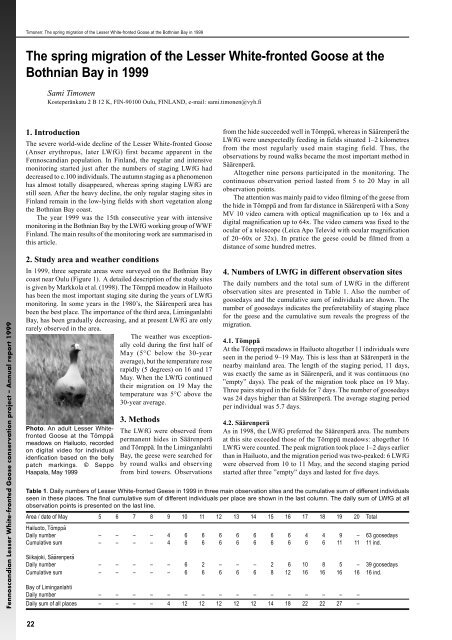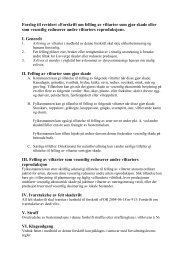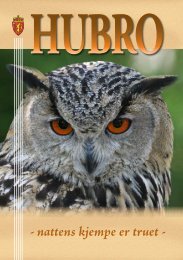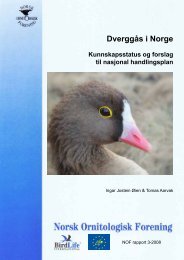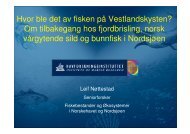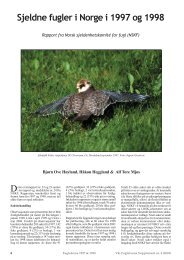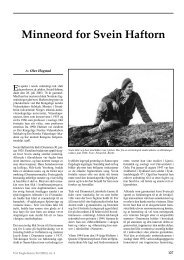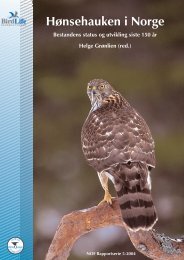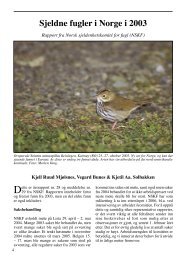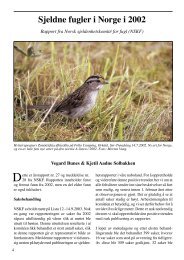Fennoscandian Lesser White-fronted Goose conservation project ...
Fennoscandian Lesser White-fronted Goose conservation project ...
Fennoscandian Lesser White-fronted Goose conservation project ...
You also want an ePaper? Increase the reach of your titles
YUMPU automatically turns print PDFs into web optimized ePapers that Google loves.
<strong>Fennoscandian</strong> <strong>Lesser</strong> <strong>White</strong>-<strong>fronted</strong> <strong>Goose</strong> <strong>conservation</strong> <strong>project</strong> – Annual report 1999<br />
Timonen: The spring migration of the <strong>Lesser</strong> <strong>White</strong>-<strong>fronted</strong> <strong>Goose</strong> at the Bothnian Bay in 1999<br />
The spring migration of the <strong>Lesser</strong> <strong>White</strong>-<strong>fronted</strong> <strong>Goose</strong> at the<br />
Bothnian Bay in 1999<br />
1. Introduction<br />
The severe world-wide decline of the <strong>Lesser</strong> <strong>White</strong>-<strong>fronted</strong> <strong>Goose</strong><br />
(Anser erythropus, later LWfG) first became apparent in the<br />
<strong>Fennoscandian</strong> population. In Finland, the regular and intensive<br />
monitoring started just after the numbers of staging LWfG had<br />
decreased to c.100 individuals. The autumn staging as a phenomenon<br />
has almost totally disappeared, whereas spring staging LWfG are<br />
still seen. After the heavy decline, the only regular staging sites in<br />
Finland remain in the low-lying fields with short vegetation along<br />
the Bothnian Bay coast.<br />
The year 1999 was the 15th consecutive year with intensive<br />
monitoring in the Bothnian Bay by the LWfG working group of WWF<br />
Finland. The main results of the monitoring work are summarised in<br />
this article.<br />
2. Study area and weather conditions<br />
In 1999, three seperate areas were surveyed on the Bothnian Bay<br />
coast near Oulu (Figure 1). A detailed description of the study sites<br />
is given by Markkola et al. (1998). The Tömppä meadow in Hailuoto<br />
has been the most important staging site during the years of LWfG<br />
monitoring. In some years in the 1980’s, the Säärenperä area has<br />
been the best place. The importance of the third area, Liminganlahti<br />
Bay, has been gradually decreasing, and at present LWfG are only<br />
rarely observed in the area.<br />
The weather was exceptionally<br />
cold during the first half of<br />
May (5°C below the 30-year<br />
average), but the temperature rose<br />
rapidly (5 degrees) on 16 and 17<br />
May. When the LWfG continued<br />
their migration on 19 May the<br />
temperature was 5°C above the<br />
30-year average.<br />
22<br />
Sami Timonen<br />
Kosteperänkatu 2 B 12 K, FIN-90100 Oulu, FINLAND, e-mail: sami.timonen@vyh.fi<br />
Photo. An adult <strong>Lesser</strong> <strong>White</strong><strong>fronted</strong><br />
<strong>Goose</strong> at the Tömppä<br />
meadows on Hailuoto, recorded<br />
on digital video for individual<br />
idenfication based on the belly<br />
patch markings. © Seppo<br />
Haapala, May 1999<br />
3. Methods<br />
The LWfG were observed from<br />
permanent hides in Säärenperä<br />
and Tömppä. In the Liminganlahti<br />
Bay, the geese were searched for<br />
by round walks and observing<br />
from bird towers. Observations<br />
from the hide succeeded well in Tömppä, whereas in Säärenperä the<br />
LWfG were unexpectedly feeding in fields situated 1–2 kilometres<br />
from the most regularly used main staging field. Thus, the<br />
observations by round walks became the most important method in<br />
Säärenperä.<br />
Altogether nine persons participated in the monitoring. The<br />
continuous observation period lasted from 5 to 20 May in all<br />
observation points.<br />
The attention was mainly paid to video filming of the geese from<br />
the hide in Tömppä and from far distance in Säärenperä with a Sony<br />
MV 10 video camera with optical magnification up to 16x and a<br />
digital magnification up to 64x. The video camera was fixed to the<br />
ocular of a telescope (Leica Apo Televid with ocular magnification<br />
of 20–60x or 32x). In pratice the geese could be filmed from a<br />
distance of some hundred metres.<br />
4. Numbers of LWfG in different observation sites<br />
The daily numbers and the total sum of LWfG in the different<br />
observation sites are presented in Table 1. Also the number of<br />
goosedays and the cumulative sum of individuals are shown. The<br />
number of goosedays indicates the preferetability of staging place<br />
for the geese and the cumulative sum reveals the progress of the<br />
migration.<br />
4.1. Tömppä<br />
At the Tömppä meadows in Hailuoto altogether 11 individuals were<br />
seen in the period 9–19 May. This is less than at Säärenperä in the<br />
nearby mainland area. The length of the staging period, 11 days,<br />
was exactly the same as in Säärenperä, and it was continuous (no<br />
”empty” days). The peak of the migration took place on 19 May.<br />
Three pairs stayed in the fields for 7 days. The number of goosedays<br />
was 24 days higher than at Säärenperä. The average staging period<br />
per individual was 5.7 days.<br />
4.2. Säärenperä<br />
As in 1998, the LWfG preferred the Säärenperä area. The numbers<br />
at this site exceeded those of the Tömppä meadows: altogether 16<br />
LWfG were counted. The peak migration took place 1–2 days earlier<br />
than in Hailuoto, and the migration period was two-peaked: 6 LWfG<br />
were observed from 10 to 11 May, and the second staging period<br />
started after three ”empty” days and lasted for five days.<br />
Table 1. Daily numbers of <strong>Lesser</strong> <strong>White</strong>-<strong>fronted</strong> Geese in 1999 in three main observation sites and the cumulative sum of different individuals<br />
seen in these places. The final cumulative sum of different individuals per place are shown in the last column. The daily sum of LWfG at all<br />
observation points is presented on the last line.<br />
Area / date of May<br />
Hailuoto, Tömppä<br />
5 6 7 8 9 10 11 12 13 14 15 16 17 18 19 20 Total<br />
Daily number – – – – 4 6 6 6 6 6 6 6 4 4 9 – 63 goosedays<br />
Cumulative sum – – – – 4 6 6 6 6 6 6 6 6 6 11 11 11 ind.<br />
Siikajoki, Säärenperä<br />
Daily number – – – – – 6 2 – – – 2 6 10 8 5 – 39 goosedays<br />
Cumulative sum – – – – – 6 6 6 6 6 8 12 16 16 16 16 16 ind.<br />
Bay of Liminganlahti<br />
Daily number – – – – – – – – – – – – – – – –<br />
Daily sum of all places – – – – 4 12 12 12 12 12 14 18 22 22 27 –


